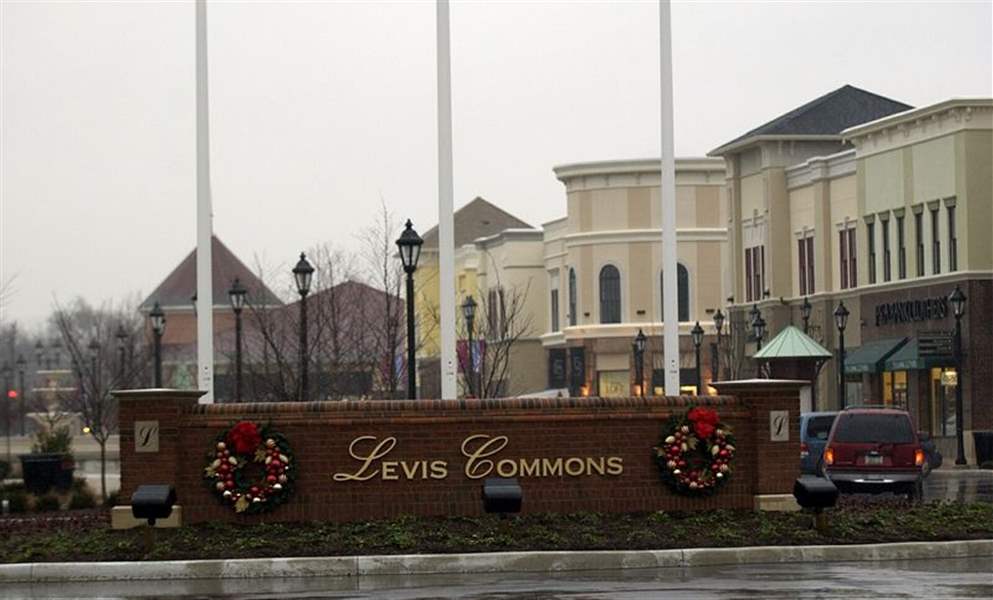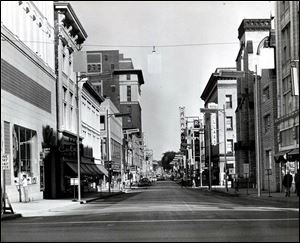
Nostalgia for downtown
11/28/2004
Perrysburg's new shopping center is surrounded by high-income residents.
Morrison / Blade photo

Perrysburg's new shopping center is surrounded by high-income residents.
Oldies stations, especially this time of year, mythologize it in tunes recorded years ago:
"The lights are much brighter there, You can forget all your troubles"
"City sidewalks, busy sidewalks -- Children laughing, people passing, meeting smile after smile"
In Perrysburg, developers spent millions of dollars to re-create the feeling of an old downtown -a place that, today, exists mostly in the memories of Americans over 40 but that provided inspiration to generations of lyricists and spenders alike.
But, in downtown Toledo, despite some recent sparks, the real thing sits largely ignored by retailers. And developers say that re-creating a lifestyle center like Perrysburg's Town Center at Levis Commons in downtown Toledo would be a lot harder than it looks.
Larry Dillin is in a position to know.
He led the partnership that created Levis Commons, a $55 million open-air development that mixes specialty stores, restaurants, and entertainment with the look of an old downtown street scene that encourages browsing.
"There are some challenges," Mr. Dillin said. "I'm not saying it wouldn't work in a downtown. But it likely does not work in Toledo."

Downtown Toledo's Adams Street was a thriving shopping destination in 1960.
For one, downtown is too close to Westfield Shoppingtown Franklin Park, a west side mall that is the area's dominant shopping venue, with department stores such as Dillard's and Marshall Field's and popular specialty stores like Abercrombie & Fitch and Eddie Bauer. Not even Levis Commons was able to land a big department store.
But specialty stores, which are part of large national companies and which would be necessary to make a downtown lifestyle center viable, want locations in a city to be "at polar opposite ends of the market so they don't overlap," he said. Parking is another issue, he said, noting that customers at places like Levis Commons want free parking close by.
But a bigger reason, he said, is that incomes aren't high enough in downtown and surrounding neighborhoods.
Although the figure is certainly on the rise with the creation in recent years of loft condominiums and high-priced apartments downtown, the 2000 Census suggested that most residents of the area were near or below the poverty line. Median household incomes ranged from $9,300 to $13,000, Census figures show.
Nearby residents' income is a key consideration for retailers deciding where to place stores, Mr. Dillin said.
"The economic demographics for the central Toledo area are pretty dismal," he added. "If you want to attract the stores we have in Perrysburg, it doesn't work." The downtown area also lacks a sufficient number of households.
In contrast, 41 percent of families who live near Levis Commons make at least $75,000, according to statistics given to prospective tenants. Sixty-one percent have incomes of at least $50,000.
Chain retailers in Levis Commons like Coldwater Creek women's clothier and Jos. A. Banks men's store look to two categories of customers to keep sales humming: People who live nearby and are likely to stop by daily or several times a week and shoppers from distant areas who may visit four or five times a year.
A downtown lifestyle center would be able to attract the occasional shoppers if it had the right mix of shops. But that isn't enough. "A retailer needs both groups of people," Mr. Dillin added.
Although not optimistic about chances that a lifestyle center could succeed downtown, the developer said downtown boosters should look north to Ann Arbor for a model that might work here.
That city's downtown is dotted with restaurants, sidewalk cafes, and small retail shops, most locally owned. "Most any evening - when it isn't freezing outside - the area is populated with folks strolling and dining at curbside," he explained.
Paula Brown, who has operated a gift shop downtown at 911 Jefferson Ave. for five years, said a lifestyle center probably isn't practical downtown. She said she doesn't believe the area's vintage storefronts could be adapted easily to the needs of national chains.
But the owner of the Paula Brown Shop is optimistic that retailing has a future in the city's traditional central business district.
"Retail does make it down here," she said. "We're all growing immensely," she said of a small collection of locally owned specialty shops that has increased in the last few years. "If you have something new and different, customers will travel."
Ms. Brown keeps track of the ZIP codes of customers, and notes that most patrons travel from West Toledo and Perrysburg.
Stan Eichelbaum, a retail consultant in Cincinnati, said a lifestyle center in downtown Toledo would face uphill odds because of the residential demographics.
But he noted that lifestyle centers are succeeding in some downtowns such as Portland, Ore., and on the fringe of the downtown in Salt Lake City.
Bill Ryan, who advocates for downtowns as a business development specialist at the University of Wisconsin in Madison, is no fan of lifestyle centers. They are not a good model for downtown redevelopment, he argued.
"A lot of these lifestyle centers seem to cater to the affluent suburban market," he said. "They're sterilized shopping centers that don't really have all of the services and mixed uses you would have in a true downtown. They give suburban shoppers an alternative to boring shopping malls that people are tired of."
In some cities where central business districts remain vibrant, lifestyle centers are a threat to downtowns, he added.
Overall, Mr. Ryan is optimistic about the future of downtowns, citing as an example Madison, a university town that is about the same size as Toledo. "Downtown is booming," he said. "They can't build enough housing."
The future of downtowns, he said, rests not in returning to their role of yesteryear as a one-stop retailing center. "They need to creating a combination of residential, entertainment, and retail with a certain chemistry."
Contact Gary Pakulski at: gpakulski@theblade.com or 419-724-6082.